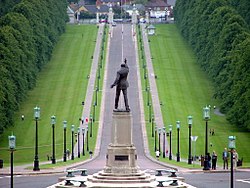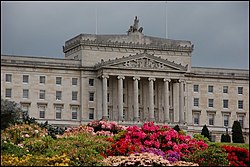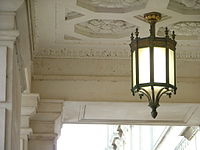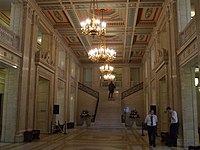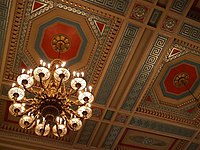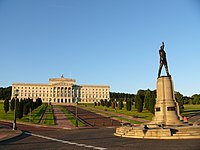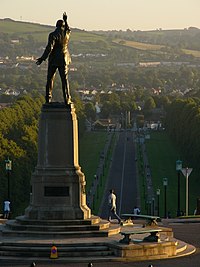Difference between revisions of "Stormont"
m (clean up, typos fixed: proceded → proceeded) |
|||
| Line 1: | Line 1: | ||
| − | + | {{infobox building | |
| + | |county=Down | ||
| + | |picture=StormontGeneral.jpg | ||
| + | |picture caption=A general view of the Parliament Buildings | ||
| + | |address=Belfast 4 | ||
| + | |latitude=54.604976 | ||
| + | |longitude=-5.831997 | ||
| + | }} | ||
The '''Stormont Estate''' is a Crown estate east of [[Belfast]] in [[County Down]], within the [[townland]] of [[Ballymiscaw]]. The Stormont Estate includes Northern Ireland's main government buildings, and all is surrounded mainly by woodland. | The '''Stormont Estate''' is a Crown estate east of [[Belfast]] in [[County Down]], within the [[townland]] of [[Ballymiscaw]]. The Stormont Estate includes Northern Ireland's main government buildings, and all is surrounded mainly by woodland. | ||
In most ears "Stormont" refers to the grand Parliament Buildings here, built for the Parliament of Northern Ireland, later abandoned and subsequently reoccupied by the Northern Ireland Assembly. This is the largest and most prominent building on the estate, though the estate contains several important buildings, both grand and bland, concerned with the business of government. | In most ears "Stormont" refers to the grand Parliament Buildings here, built for the Parliament of Northern Ireland, later abandoned and subsequently reoccupied by the Northern Ireland Assembly. This is the largest and most prominent building on the estate, though the estate contains several important buildings, both grand and bland, concerned with the business of government. | ||
| − | |||
==Buildings== | ==Buildings== | ||
| − | [[File:Northern Ireland Parliament Buildings - Edward Carson statue.jpg | + | [[File:Northern Ireland Parliament Buildings - Edward Carson statue.jpg|thumb|250px|Statue of Carson on Prince of Wales Avenue]] |
The main buildings of the estate are: | The main buildings of the estate are: | ||
| Line 91: | Line 97: | ||
==References== | ==References== | ||
{{Reflist}} | {{Reflist}} | ||
| − | |||
| − | |||
{{Catself}} | {{Catself}} | ||
[[Category:Estates in County Down]] | [[Category:Estates in County Down]] | ||
[[Category:Buildings and structures in County Down]] | [[Category:Buildings and structures in County Down]] | ||
Latest revision as of 16:55, 21 September 2017
| Stormont | |
|
County Down | |
|---|---|
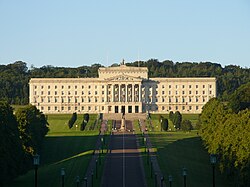 A general view of the Parliament Buildings | |
| Location | |
| Location: | 54°36’18"N, 5°49’55"W |
| History | |
| Address: | Belfast 4 |
| Information | |
The Stormont Estate is a Crown estate east of Belfast in County Down, within the townland of Ballymiscaw. The Stormont Estate includes Northern Ireland's main government buildings, and all is surrounded mainly by woodland.
In most ears "Stormont" refers to the grand Parliament Buildings here, built for the Parliament of Northern Ireland, later abandoned and subsequently reoccupied by the Northern Ireland Assembly. This is the largest and most prominent building on the estate, though the estate contains several important buildings, both grand and bland, concerned with the business of government.
Contents
Buildings
The main buildings of the estate are:
| Building | Image | About |
|---|---|---|
| Castle Buildings |  |
Administrative buildings, including the Office of the First Minister and deputy First Minister, the Department of Health, Social Services and Public Safety and the Department of Justice. |
| Dundonald House |  |
Headquarters of the Northern Ireland Civil Service, the Department of Agriculture and Rural Development and Northern Ireland Prison Service. |
| Craigantlet Buildings | Headquarters of the Department of Finance and Personnel. | |
| Maynard Sinclair Pavilion | Home to the Northern Ireland Civil Service Sports and Social Club. | |
| Parliament Buildings |  |
Seat of the Northern Ireland Assembly and formerly of the Parliament of Northern Ireland. This building is commonly referred to as Stormont. |
| Stormont Castle |  |
Seat of the Northern Ireland Executive |
| Stormont House | Headquarters of the Northern Ireland Office (also known as Speaker's House) |
Parliament Buildings
Parliament Buildings, commonly known as Stormont because of its location in the Stormont Estate area of Belfast, is the seat of the Northern Ireland Assembly. It previously housed the Parliament of Northern Ireland, before its suspension and abolition.
History
Original plans
The need for a parliament building for Northern Ireland emerged with the creation of Northern Ireland as a Home Rule region by the Government of Ireland Act 1920. Pending the construction of the new building, the parliament met first in Belfast City Hall, where the state opening of the first parliament by King George V took place in on 22 June 1921, and also in the nearby Assembly's College of the Presbyterian Church in Ireland. In 1922, preparatory work on the chosen site, east of Belfast, began. The original plans were for a large domed building with two subsidiary side buildings, housing all three branches of government – legislative, executive and judicial.
The plans were scaled back following the Stock Market Crash of 1929 and the Great Depression which followed. Instead, a smaller, domeless building designed by Sir Arnold Thornley in the Greek classical style and fronted in Portland stone, was erected on the site.[1] It was built by Stewart & Partners and opened by Edward, Prince of Wales (later King Edward VIII) on 16 November 1932.[2]
Finished building
After the shelving of plans to build a "Ministerial Building'", the headquarters of government was in effect Stormont Castle, a baronial castellated house in the grounds and which was originally meant to have been demolished to make way for the "Ministerial Building". Stormont Castle served as the official residence of the Prime Minister of Northern Ireland and was the meeting place for the Northern Ireland cabinet. Another residence, Stormont House served as the official residence of the Speaker of the House of Commons of Northern Ireland. The reduced plans saw the High Court eventually built in Belfast city centre, and two extra levels being added to Parliament Buildings to serve as extra office space required after the loss of the Ministerial Building.
Two separate chambers were provided in the finished parliamentary complex, the blue-benched rectangular House of Commons of Northern Ireland (green benches as at Westminster being considered inappropriate) and the red-benched smaller rectangular Senate of Northern Ireland. In the main hall, called the Great Hall, a large gold-plated chandelier was hung. It was a gift from King George V and had originally hung in Windsor Castle, where it had been a gift of Kaiser Wilhelm II of Germany. The Kaiser's chandelier had been removed from Windsor and placed in storage during the First World War and was never hung in Windsor again.
The painting The Entry of King William into Ireland, a gift from the Dutch government to its Northern Ireland counterpart, was hung in the House of Commons when it opened. However, it was removed after having been defaced by a Scottish preacher, who had travelled from Scotland for that express purpose. The reason for his anger was that the painting also showed the Pope, who had blessed William's enterprise.
The building itself changed little over the years, even as the parliaments meeting inside it did. To camouflage it during Second World War, the building's Portland stone was painted with supposedly removable "paint" made of bitumen and cow manure. However, after the war, removing the paint proved an enormous difficulty, with the paint having scarred the stonework. It took seven years to remove the "paint", and the exterior façade has never regained its original white colour. While most traces of it were removed from the façades (though having done damage that can be seen up close), some of the remains of the paint survive in the inner courtyards and unseen parts of the place.
Statues
Additional changes to the building and its environs include the erection of a statue to Edward, Lord Carson in dramatic pose (on the drive leading up to the building) in 1932, a rare example of a statue to a person being erected before death, and the erection of a statue to Lord Craigavon in the main foyer, half way up the grand staircase. Craigavon served as the first Prime Minister of Northern Ireland, and he and his wife are buried in the estate grounds.
Uses for the building
The building was used for the Parliament of Northern Ireland until it was prorogued in 1972. The Senate chamber was used by the Royal Air Force as an operations room during Second World War. The building was used for the short-lived Sunningdale power-sharing executive in 1974. Between 1973 and 1998, it served as the headquarters of the Northern Ireland civil service. Between 1982 and 1986, it served as the seat of the rolling-devolution assembly. It is now the home of the Northern Ireland Assembly.
In the 1990s, Sinn Féin suggested that a new parliament building for Northern Ireland should be erected, saying that the building at Stormont was too controversial and too associated with unionist rule to be used by a power-sharing assembly. However, no one else supported the demand and the new assembly and executive was installed there as its permanent home.
On 3 December 2005, the Great Hall was used for the funeral service of former Northern Ireland and Manchester United footballer George Best. The building was selected for the funeral as it is in the only grounds in Belfast suitable to accommodate the large number of members of the public who wished to attend the funeral. Approximately 25,000 people gathered in the grounds, with thousands more lining the cortege route. It was the first time since Second World War that the building has been used for a non-governmental or non-political purpose.
In springtime in 2006, however, the building was reopened for political talks between the Members of the Legislative Assembly from the various political parties in Northern Ireland.
On 29 September 2012, the grounds were used for an Orange Order parade in memory of the signing of the Ulster Covenant. 60,000 people thronged the grounds after a massive parade through the streets of Belfast.
The chambers
Assembly Chamber
The original House of Commons of Northern Ireland was designed in the standard adversarial form, with the government and opposition facing each other in parallel blue benches across a central aisle.
The original House of Commons chamber was slightly redesigned in the 1970s with the addition of a block of curved benches facing the Speaker's chair, along with new curved front benches for some of the remainder of the furnishings, to reduce the adversarial nature of the chamber and provide a symbolic middle ground for middle ground parties.
The entire House of Commons chamber was destroyed by fire on 2 January 1995 which was blamed on an electrical fault in the wiring below the Speaker's chair. The destruction of the chamber allowed the creation of the modern less confrontational chamber used now by the power-sharing Northern Ireland Assembly.
Senate
The Senate chamber, with its red leather adversarial seats in two parallel blocks of benches remains as it was originally designed. Irish damask linen hangs on the walls; plans to line the walls with large oil paintings were not proceeded with.
The chamber has not been used as a parliamentary chamber in plenary session since the suspension of devolved government in 1972. The Senate chamber is now used as a committee room. There have been few changes made to the chamber since the building opened in 1932. One change is the installation of television cameras and microphones. Another is the addition of two paintings. One painting, which is untitled, depicts the state opening of the Northern Ireland Parliament in 1921. Facing this painting on the opposing wall is The House Shall Divide, a group portrait of the members elected to the inaugural Assembly in the 1998 Assembly election.
A further alteration that has been made to the chamber since 1932 is the addition of an inscription in the marble of the balustrade of the Senate Chambers Press Gallery. The message reads: "This inscription records the gratitude of His Majesty's Government in the United Kingdom for the use of this chamber as an operations room by the Royal Air Force during the Second World War."
Outside links
| ("Wikimedia Commons" has material about Stormont) |
- NI Assembly - The Stormont Estate
- Online tour of Parliament Buildings
- Photographic tour of Parliament Buildings, Stormont
- Fully searchable record of parliamentary debates at Stormont from 1921 to 1972
References
- ↑ "Stormont: Construction of seat of power is marked". BBC News. 23 October 2012. http://www.bbc.co.uk/news/uk-northern-ireland-20044194.
- ↑ Hansard 15 November 1932
